
Forex Trading Basics: An Introductory Guide
Forex trading, or foreign exchange trading, is the act of buying and selling currencies on the foreign exchange market. It is one of the largest and most liquid markets in the world, with daily trading volumes exceeding $6 trillion. This article aims to provide a foundational understanding of forex trading, including key concepts, terminology, and basic strategies to get started. You can also explore more resources at forex trading basics https://forex-level.com/.
What is Forex Trading?
Forex trading involves the simultaneous buying of one currency and selling of another. Currencies are always quoted in pairs, such as EUR/USD, where the first currency (EUR) is the base currency, and the second currency (USD) is the quote currency. The price of a currency pair reflects how much of the quote currency is needed to purchase one unit of the base currency.
Understanding Currency Pairs
Currency pairs are categorized into three types:
- Major Pairs: These include the most traded currencies, such as EUR/USD, USD/JPY, and GBP/USD.
- Minor Pairs: These pairs do not involve the US dollar, such as EUR/GBP or AUD/NZD.
- Exotic Pairs: These consist of one major currency paired with a currency from a developing economy, like USD/TRY (Turkish Lira).

Key Terminology
Before delving deeper into forex trading, it’s crucial to understand some key terminology:
- Pip: A pip is the smallest price move that a given exchange rate can make based on market convention. Usually, in currency pairs, a pip is equivalent to 0.0001.
- Spread: The spread is the difference between the bid (selling) price and the ask (buying) price of a currency pair.
- Leverage: Leverage allows traders to control larger positions with a relatively smaller amount of capital. For instance, a leverage of 100:1 means that for every $1 in your account, you can control $100 in the market.
- Margin: Margin refers to the amount of capital required to open and maintain a leveraged position. It is usually expressed as a percentage of the full position size.
Market Participants
Different entities participate in the forex market, including:
- Central Banks: They influence the market through monetary policy and currency interventions.
- Financial Institutions: Banks and financial firms trade currencies for their clients and for proprietary trading.
- Corporations: Companies engaged in international trade may exchange currencies to facilitate business operations.
- Retail Traders: Individual investors who trade currencies through brokerage platforms.
How to Start Trading Forex
If you’re interested in forex trading, here’s a step-by-step guide to get started:

- Educate Yourself: Learn the principles of forex trading and familiarize yourself with the terminology.
- Choose a Reliable Broker: Select a reputable forex broker that offers a user-friendly trading platform, competitive spreads, and satisfactory customer support.
- Open a Trading Account: Sign up for a trading account with the chosen broker. Most brokers offer demo accounts to practice trading without real money.
- Develop a Trading Plan: Create a plan outlining your trading strategy, risk management rules, and trading goals.
- Start Trading: Execute trades based on your analysis and strategy. Monitor your positions and the overall market regularly.
Basic Trading Strategies
There are various trading strategies that beginners can consider:
- Day Trading: This strategy involves opening and closing trades within the same day.
- Swing Trading: Swing traders hold positions for several days or weeks to capture price changes.
- Scalping: Scalpers make quick trades to profit from minor price movements, often holding positions for a few seconds to minutes.
- Position Trading: Position traders hold onto their trades for months, focusing on long-term market trends.
Risk Management in Forex Trading
Effective risk management is essential in forex trading. Here are some key practices:
- Set Stop-Loss Orders: These orders automatically close your trade at a specified price to limit potential losses.
- Regularly Evaluate Your Performance: Keep track of your trades to identify patterns and improve your strategies.
- Diversify Your Trading Portfolio: Avoid putting all your capital into one trade or currency pair; diversify to spread risk.
Conclusion
Forex trading can be a rewarding venture for those who educate themselves and approach it with a disciplined mindset. By understanding the basics of the forex market, familiarizing yourself with key terminology, and implementing sound trading strategies and risk management practices, you can increase your chances of success. As you embark on your trading journey, remember that patience and continuous learning are key to becoming a proficient forex trader.
